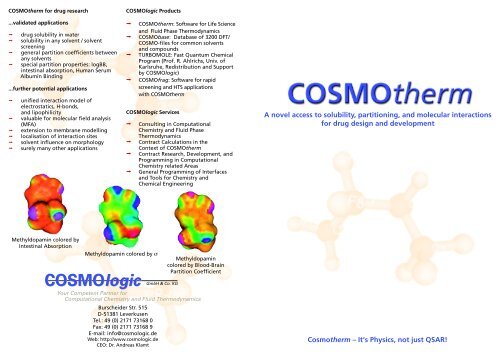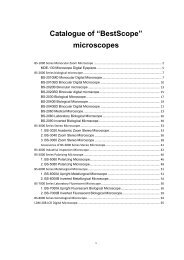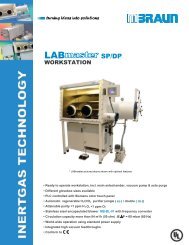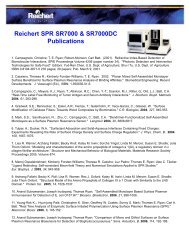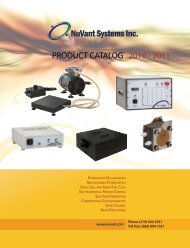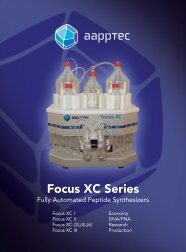COSMOtherm Life Sciences - ACS
COSMOtherm Life Sciences - ACS
COSMOtherm Life Sciences - ACS
Create successful ePaper yourself
Turn your PDF publications into a flip-book with our unique Google optimized e-Paper software.
<strong>COSMOtherm</strong> for drug research<br />
...validated applications<br />
j drug solubility in water<br />
j solubility in any solvent / solvent<br />
screening<br />
j general partition coefficients between<br />
any solvents<br />
j special partition properties: logBB,<br />
intestinal absorption, Human Serum<br />
Albumin Binding<br />
...further potential applications<br />
j unified interaction model of<br />
electrostatics, H-bonds,<br />
and lipophilicity<br />
j valuable for molecular field analysis<br />
(MFA)<br />
j extension to membrane modelling<br />
j localisation of interaction sites<br />
j solvent influence on morphology<br />
j surely many other applications<br />
Methyldopamin colored by<br />
Intestinal Absorption<br />
COSMOlogic GmbH<br />
COSMOlogic Products<br />
j <strong>COSMOtherm</strong>: Software for <strong>Life</strong> Science<br />
and Fluid Phase Thermodynamics<br />
j COSMObase: Database of 3200 DFT/<br />
COSMO-files for common solvents<br />
and compounds<br />
j TURBOMOLE: Fast Quantum Chemical<br />
Program (Prof. R. Ahlrichs, Univ. of<br />
Karlsruhe, Redistribution and Support<br />
by COSMOlogic)<br />
j COSMOfrag: Software for rapid<br />
screening and HTS applications<br />
with <strong>COSMOtherm</strong><br />
COSMOlogic Services<br />
Methyldopamin colored by σ<br />
j Consulting in Computational<br />
Chemistry and Fluid Phase<br />
Thermodynamics<br />
j Contract Calculations in the<br />
Context of <strong>COSMOtherm</strong><br />
j Contract Research, Development, and<br />
Programming in Computational<br />
Chemistry related Areas<br />
j General Programming of Interfaces<br />
and Tools for Chemistry and<br />
Chemical Engineering<br />
& Co. KG<br />
Methyldopamin<br />
colored by Blood-Brain<br />
Partition Coefficient<br />
Your Competent Partner for<br />
Computational Chemistry and Fluid Thermodynamics<br />
Burscheider Str. 515<br />
D-51381 Leverkusen<br />
Tel.: 49 (0) 2171 73168 0<br />
Fax: 49 (0) 2171 73168 9<br />
E-mail: info@cosmologic.de<br />
Web: http://www.cosmologic.de<br />
CEO: Dr. Andreas Klamt<br />
A novel access to solubility, partitioning, and molecular interactions<br />
for drug design and development<br />
Cosmotherm – It‘s Physics, not just QSAR!
<strong>COSMOtherm</strong> (originally COSMO-RS) derives<br />
the thermophysical behavior of liquids from<br />
the information provided by unimolecular<br />
quantum chemical calculations (DFT) on the<br />
compounds of interest. In these calculations<br />
each molecule is handled as if it was embedded<br />
in a conductor (COSMO-approximation).<br />
As a result, the screening charge density σ is<br />
available on each part of<br />
the molecular<br />
surface, as it is<br />
illustrated by<br />
vanillin on the<br />
right.<br />
As a second step<br />
all interactions<br />
of molecules in<br />
liquids are described<br />
as contact<br />
interactions of molecular surfaces, and<br />
the interaction energies are quantified using<br />
the screening charge densities σ and σ‘ of the<br />
two interacting surface pieces. This results in<br />
the expressions<br />
2<br />
Ehb (σ,σ' ) = aeff ehb (σ,σ' ) = aeff chb min{0,σσ' +σ hb }<br />
α'<br />
Emisfit (σ,σ' ) = aeffe misfit (σ ,σ' ) = aeff (σ + σ' )2<br />
2<br />
for the electrostatic misfit and for the hydrogen<br />
bonding energy, respectively. The few<br />
parameters appearing in these formulae have<br />
been carefully adjusted to experimental data.<br />
p X (σ)<br />
25<br />
20<br />
15<br />
10<br />
5<br />
For an efficient statistical thermodynamics<br />
calculation the molecular surfaces are<br />
virtually split into small pieces of size aeff,<br />
and contacts of such pieces are considered as<br />
independent. This approach (which is similar<br />
to the assumption of interacting surfaces in<br />
group contribution methods) corresponds to<br />
a reduction of the spatial screening charge<br />
distribution to a one-dimensional histogram,<br />
which we call σ-profile. As illustrated below<br />
σ-profiles p X(σ) are characteristic for each<br />
compound X.<br />
It is important to note, that the σ-profile p S(σ)<br />
of a mixture S is simply given by the weighted<br />
sum of the σ-profiles of the components. Now<br />
the statistical thermodynamics of the system<br />
S of interacting surface pieces is calculated by<br />
an efficient and exact algorithm, ending up<br />
with a chemical potential of each component<br />
X. At this point, activity coefficients and<br />
many other thermophysical properties of the<br />
system (e.g. excess enthalpy and entropy and<br />
even vapor pressure) are readily available.<br />
This novel statistical thermodynamics is more<br />
exact than the algorithm used in group<br />
contribution methods, avoiding any meanfield<br />
assumption and hence being as reliable<br />
in the limit of infinite dilution as it is with<br />
finite concentrations.<br />
0<br />
-0,020 -0,015 -0,010 -0,005 0,000 0,005 0,010 0,015 0,020<br />
σ[e/A 2 ]<br />
Water<br />
Methanol<br />
Benzene<br />
Hexane<br />
Calculation of Solubility<br />
Solubility of any liquid compound<br />
X in pure and mixed solvents and<br />
especially in water is readily<br />
calculated by COSMO-RS making use<br />
of the chemical potentials of X in the<br />
solvent and in its pure liquid state. In<br />
order to be able to predict solubilities<br />
of solid compounds, ∆G fusion has<br />
been fitted by physically meaningful<br />
regression using only 3 descriptors<br />
from <strong>COSMOtherm</strong>. As shown on a<br />
test set of pesticides, this method<br />
is very predictive even if applied to<br />
very different drugs and pesticides.<br />
Partition Coefficients<br />
Partition coefficients between well-known<br />
solvent systems like octanol-water are<br />
available by <strong>COSMOtherm</strong> since the chemical<br />
logBB exp.<br />
2<br />
1,5<br />
1<br />
0,5<br />
0<br />
-0,5<br />
-1<br />
-1,5<br />
-2<br />
rms = 0.43<br />
R<br />
n = 63<br />
2 = 0.78<br />
Experiment<br />
1<br />
0<br />
-1<br />
-2<br />
-3<br />
-4<br />
-5<br />
-6<br />
-7<br />
-8<br />
-9<br />
-10<br />
-11<br />
-12<br />
-13<br />
Water Solubility log(xH2O)<br />
calculated with <strong>COSMOtherm</strong><br />
QikProp-Dataset of Jorgensen and Duffy<br />
R<br />
rms = 0.66<br />
n = 150<br />
2<br />
= 0.90<br />
-13 -12 -11 -10 -9 -8 -7 -6 -5 -4 -3 -2 -1 0 1<br />
Calculated<br />
σ-moment regression<br />
for blood-brain<br />
partitioning<br />
Efficiency Aspects<br />
-2,5<br />
-2 -1,5 -1 -0,5 0<br />
logBB regr.<br />
0,5 1 1,5 2<br />
potential of each compound in the two<br />
phases can be calculated. The chemical composition<br />
of biological systems often is unknown<br />
and in addition the phases may be inhomo-<br />
geneous. In these cases the σ-moment<br />
approach allows for the set up of QSPR<br />
models. Several ADME properties successfully<br />
have been calculated, such as: blood brain<br />
partition, intestinal absorption and human<br />
serum albumin binding.<br />
DGfus < 0<br />
DGfus > 0<br />
McFarland Test Set<br />
The quantum chemical density functional (DFT)<br />
COSMO calculations based on semi-empirical<br />
geometries can nowadays be run in about<br />
8min for typical drug compounds<br />
even on normal PC-processors.<br />
<strong>COSMOtherm</strong> itself only takes<br />
milliseconds for a calculation and is<br />
able to run on any Windows or UNIX/<br />
LINUX computer. For rapid screening<br />
and HTS applications a shortcut<br />
of <strong>COSMOtherm</strong> (COSMOfrag) is<br />
available which derives σ-profiles<br />
from precalculated similar<br />
molecules. COSMOfrag calculations<br />
take only a few seconds per<br />
compound and thus allow for<br />
<strong>COSMOtherm</strong> usage in HTS projects.<br />
References:<br />
A. Klamt, J. Phys. Chem. 99 (1995) 2224.<br />
F.Eckert, A. Klamt‚ AIChE J. 48 (2002) 369.<br />
A. Klamt, F. Eckert, M. Hornig, M. Beck,<br />
T. Bürger, J. Comp. Chem. 23 (2002) 275.<br />
R. Jones, P. C. Conolly, A. Klamt,<br />
M. Diedenhofen,<br />
J. Chem. Inf. Model. 45 (2005) 1337.<br />
K. Wichmann, M. Diedenhofen, A. Klamt,<br />
J. Chem. Inf. Model. 47 (2007) 228.


